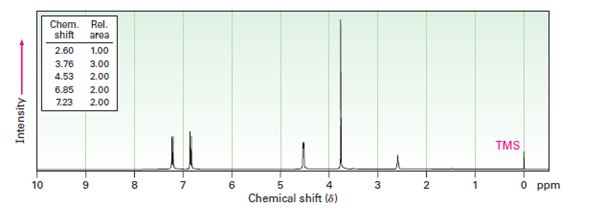
Concept explainers
Interpretation:
A structure for the alcohol with molecular formula C9H12O and the following spectral data is to be proposed.
1HNMR: 0.88 δ (triplet,Rel.area=3.00); 1.80 δ (quintet, Rel.area=2.00); 2.32 δ (Rel.area=1.00); 4.54 δ (triplet, Rel.area=1.00); 7.24 δ (Rel.area=5.00).
Concept introduction:
In 1HNMR spectrum, the alcoholic proton absorption occurs in the range 3.4 δ - 4.5 δ while that of phenolic proton occur in the range 3.0 to 8.0. The
The absorption due to 10 alkyl group (CH3) is seen around 0.7 δ - 1.3 δ, that due to a 20 alkyl group (CH2) is seen around 1.2 δ - 1.6 δ while that due to 30 alkyl group (CH) is seen around 1.4 δ - 1.8 δ The multiplicity of a signal gives an idea about the protons present in the adjacent carbons.
To propose:
A structure for the alcohol with molecular formula C9H12O and the following spectral data is to be proposed.
1HNMR: 0.88 δ (triplet,Rel.area=3.00); 1.80 δ (quintet, Rel.area=2.00); 2.32 δ (Rel.area=1.00); 4.54 δ (triplet, Rel.area=1.00); 7.24 δ (Rel.area=5.00).
b)
C8H10O2

Interpretation:
A structure for the alcohol with molecular formula C8H10O2 and the following spectral data is to be proposed.
IR: 3500 cm-1,
1HNMR: 2.60 δ (Rel.area=1.00); 3.76 δ (Rel.area=3.00); 4.53 δ (Rel.area=2.00); 6.85 δ (Rel.area=2.00); 7.23 δ (Rel.area=2.00).
Concept introduction:
In 1HNMR spectrum, the alcoholic proton absorption occurs in the range 3.4 δ - 4.5 δ while that of phenolic proton occur in the range 3.0 to 8.0. The aromatic protons give a broad peak in the range 6.5 δ - 8.0 δ, the benzylic protons normally absorb in the region 2.3 δ - 3.0 δ.
To propose:
A structure for the alcohol with molecular formula C8H10O2 and the following spectral data is to be proposed.
1HNMR: 2.60 δ (Rel.area=1.00); 3.76 δ (Rel.area=3.00); 4.53 δ (Rel.area=2.00); 6.85 δ (Rel.area=2.00); 7.23 δ (Rel.area=2.00).
Trending nowThis is a popular solution!

Chapter 17 Solutions
EP ORGANIC CHEMISTRY,24 MONTH-OWLV2
- Can you explain how I get these here and show the steps plz?arrow_forwardGive the IUPAC name for this compound Hydrocarbon Condensed Formulas Hint C2H5 CH2CH3 expand that in all the formula Part A: (CH3)2CHCH(C2H5)CH2CH2CH3 Give the IUPAC name for this compound. Part B: CH2=C(C2H5)CH2CH2CH3 Give the IUPAC name for this compound. Part C: (CH3)2C=CHC(C2H5)=CH2 Give the IUPAC name for this compound. Part D: CH3C=CCH(C2H5)2 Give the IUPAC name for this compound. Part E: (CH3)3CC=CCH2CH=C(CH3)2arrow_forwardSelect/ Match the correct letter from the image below for the IUPAC names given below: A B C D 3 E F G H K L Part 1. 4-methylheptane For example.mmmm Answer Letter H _for part 1 Part 2. 2,4-dimethylhexane Part 3. 2,3-dimethylpentane Part 4. 2,2-dimethylhexane Part 5. 2-ethyl-1,1,3,3-tetramethylcyclopentane Part 6. 3-ethyl-2-methylpentanearrow_forward
- Can u show the process as to how to get these?arrow_forwardSketch the expected 'H NMR spectra for the following compound. Label all of the H's in the structure and the corresponding signal for the spectra you sketch. Make sure you include the integration value and the splitting pattern for each signal Indicate how many signals you would expect in the 13C NMRarrow_forwardUse IUPAC naming rules to name the following hydrocarbon compounds: CH2-CH3 | a) CH-CH-CH2-CH-CH-CH3 b) | CH2 CH3 | CH3 CH3 \ / C=C H 1 H CH2-CH3 c) d) CH=C-CH3 e) CH3-CH2-CH2-CH=CH-CH3 f) CH2=CH-CH2-CH=CH-CH3 g) CH3-CH2-C = C-CH2-CH3 h)arrow_forward
- Q5 Name the following : a. b. C. d. e.arrow_forward25. Predict the major product of the following reaction. 1 equivalent of each of the starting materials was used. H₂C CH3 CH3 H3C H3C H3C. CH2 + H3C. heat CH3 CH H.C. CH3 H.C H.C CH3 CH CH3 CH3 A B C Earrow_forwardFind chemical structures based on the below information. a) Chemical formula C6H8O Compound is aromatic plus has two 1H NMR peaks that integrated for 3 each that are singlets (it could have more peaks in the 1H NMR b) Chemical Formula: C6H100 Compounds is conjugated 'H NMR has a signal that integrates for 6 and is a doublet IR spectra has a signal at 1730 cm-1arrow_forward
- Jaslev Propose a synthesis of the following starting from benzene and any other reagents and chemicals. No mechanisms are required. Indicate the condition for each step plus the major product for each step. More than two steps are required. Step 1 Step 2 مہد Brarrow_forwardPart C: The line formula for another branched alkane is shown below. i. In the IUPAC system what is the root or base name of this compound? ii. How many alkyl substituents are attached to the longest chain? iii. Give the IUPAC name for this compound.arrow_forwardPart D: Draw the Structural Formula for 4-ethyl-2-methylhexane Part E. Draw the Structural Formula for 1-chloro-3,3-diethylpentane (Chloro = Cl)arrow_forward

 Organic ChemistryChemistryISBN:9781305580350Author:William H. Brown, Brent L. Iverson, Eric Anslyn, Christopher S. FootePublisher:Cengage Learning
Organic ChemistryChemistryISBN:9781305580350Author:William H. Brown, Brent L. Iverson, Eric Anslyn, Christopher S. FootePublisher:Cengage Learning

